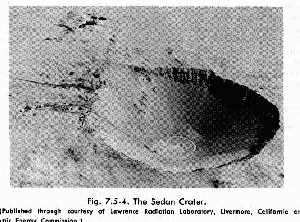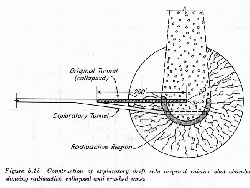Mining in Manitoba
Nuclear Blasting
The first completely contained nuclear
explosion, of 1.7 kiloton energy release (TNT equivalent) was fired on Sept. 19,1957.
Although one of the prime puposes of this blast was to test the depth of solid rock
necessary to contain a nuclear explosion, the rock breakage, seismic waves generated and
local effects of the rock were also of viatl interest.

The initial temperature in the room which contained the nuclear device was calculated to be 1,000,000 K and the pressure 7,000,000 atm. The rock melted a 15 ft. chamber and crushed the rock out to a 150 ft. radius. The top of the cavity collapsed to form a chimney ultimately 400 ft. high. About 200,000 tons of rock was fragmented.

The possible use of nuclear explosives include large-scale excavation, increasing the yield of oil wells, extraction of oil from tar sands, extraction of oil from oil shales, power production and breaking up of large low-grade ore deposits for leachin in-situ.
Return to FUTURE Menu